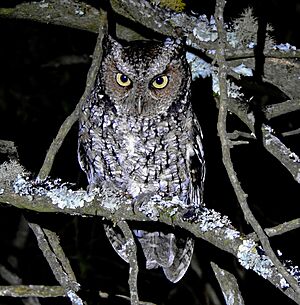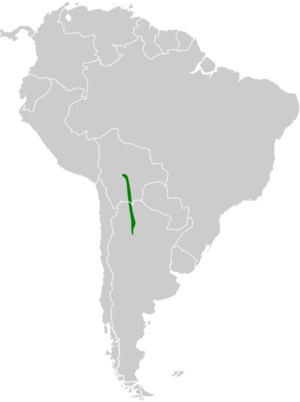Yungas screech owl facts for kids
The Yungas screech owl (Megascops hoyi) is a small, fascinating owl that lives in the forests of Argentina and Bolivia. It's also known as the montane forest screech-owl or Hoy's screech owl. This special bird belongs to the Strigidae family, which includes many types of owls.
Quick facts for kids Yungas screech owl |
|
|---|---|
 |
|
| Conservation status | |
| Scientific classification | |
| Genus: |
Megascops
|
| Species: |
hoyi
|
 |
|
Contents
About Its Name and Family
Scientists use a system called taxonomy to name and group living things. The Yungas screech owl has a scientific name, Megascops hoyi. It's the only species in its group, which means it's monotypic.
Sometimes, this owl was thought to be the same as other owls, like the black-capped screech owl. But scientists have studied their sounds and DNA. They found that the Yungas screech owl is its own unique species. Different groups of bird experts might use slightly different English names for it. For example, some call it the "Yungas screech owl," while others prefer "montane forest screech-owl."
What It Looks Like
The Yungas screech owl is about 23 to 24 cm (9.1 to 9.4 in) long, which is about the size of a small ruler. It weighs between 110 to 145 g (3.9 to 5.1 oz), which is lighter than a can of soda.
These owls can look a bit different from each other. Some are brown, some are gray, and some have a reddish-brown color (called rufous). This is known as having different morphs.
- It has a gray-brown face.
- Bright yellow eyes with white "eyebrows" above them.
- Small "ear" tufts on its head, which are just feathers.
- Its back and wings are usually brown, but they can be gray or rusty depending on the owl's morph.
- Its feathers have dark, wavy patterns and streaks.
- When its wings are closed, you can see a line of big white spots.
- Its tail has light brown stripes and wavy patterns.
- Its belly is light gray to gray-brown with a yellowish tint.
- It has clear black streaks on its chest and sides.
Where It Lives
The Yungas screech owl lives in the beautiful Yungas region. This area stretches from south-central Bolivia, specifically the Cochabamba Department, down into northwestern Argentina. You can find it as far south as Tucumán Province, and maybe even in Catamarca Province.
This owl prefers to live in moist montane forests and cloud forests. These forests have tall trees and many epiphytes, which are plants that grow on other plants. It usually lives at elevations from 1,000 to 2,600 m (3,300 to 8,500 ft) high. Sometimes, it can be found even higher, up to 2,800 m (9,200 ft). Most of these owls stay in one place, but those living higher up might move to lower areas during the winter.
How It Behaves
What It Eats
The Yungas screech owl hunts for its food in different places. It looks for prey on the ground, near the edges of the forest, and even high up in the trees. Scientists believe its diet is mostly made up of insects and spiders. However, it also eats some small animals with backbones, like tiny mammals or birds.
Reproduction and Life Cycle
These owls likely lay their eggs at the start of the rainy season, usually in September and October. They seem to prefer nesting in holes found in trees. These holes might be old ones made by woodpeckers.
How It Communicates
Yungas screech owls sing together in pairs. Their main song starts softly, then gets louder and faster with quick "u" notes, and finally fades away. The female owl's voice is higher pitched than the male's. They also have a shorter, similar song.
Its Conservation Status
The IUCN (International Union for Conservation of Nature) has looked at the Yungas screech owl. They have listed it as a species of "Least Concern." This means that its population is stable, and it's not currently at high risk of disappearing. It's "not uncommon" in some areas, and parts of its home are hard for people to reach, which helps protect it.


